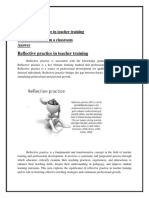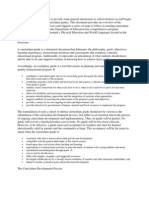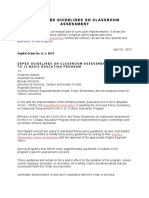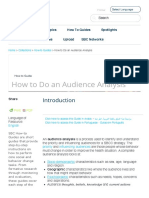Collecting Feedback From Learners and Teachers Is A Valuable Method of Curriculum Evaluation That Provides Insights Into The Effectiveness of The Curriculum
Uploaded by
Jerome Tamayo SantiagoCopyright:
Available Formats
Collecting Feedback From Learners and Teachers Is A Valuable Method of Curriculum Evaluation That Provides Insights Into The Effectiveness of The Curriculum
Uploaded by
Jerome Tamayo SantiagoOriginal Title
Copyright
Available Formats
Share this document
Did you find this document useful?
Is this content inappropriate?
Copyright:
Available Formats
Collecting Feedback From Learners and Teachers Is A Valuable Method of Curriculum Evaluation That Provides Insights Into The Effectiveness of The Curriculum
Uploaded by
Jerome Tamayo SantiagoCopyright:
Available Formats
Collecting feedback from learners and teachers is a valuable method of
curriculum evaluation that provides insights into the effectiveness of the
curriculum, its implementation, and its impact on student learning. This
feedback gathering process involves systematically collecting opinions,
perceptions, and experiences from both students and educators to assess
various aspects of the curriculum.
According to Tsi (2022), the purpose of collecting feedback is by gathering
insights into how learners (students) and teachers perceive the curriculum
content, structure, and instructional methods; identify strengths of the
curriculum that enhance learning experiences and weaknesses that need
improvement; determine the level of student engagement and the perceived
relevance of the curriculum to students' educational and personal goals; and
gather feedback on the effectiveness of curriculum implementation strategies
and instructional practices.
In order to collect feedback from learners or students, teachers can
administer structured surveys that include questions about students’
experiences with the curriculum, their understanding of content, and their
engagement in learning activities; conduct focus group discussions with a small
group of students to explore their opinions in more depth, allowing for
interactive and open-ended feedback; conduct one-on-one interviews with
selected students to gather detailed insights and perspectives on specific
aspects of the curriculum; and encourage students to maintain journals or logs
where they can regularly reflect on their learning experiences, challenges faced,
and suggestions for improvement.
Feedback can also be collected not only from students but also to their co-
teachers. To do this, they can administer surveys to coteachers that cover topics
such as their perceptions of curriculum effectiveness, adequacy of instructional
resources, and professional development needs related to curriculum
implementation; conduct individual or group interviews with co-teachers to
discuss their experiences with the curriculum, challenges encountered, and
suggestions for adjustments; organize focus groups with teachers to facilitate
discussions on curriculum strengths, weaknesses, and collaborative
brainstorming on improvement strategies; and use professional development
workshops or sessions to gather informal feedback from teachers on curriculum-
related topics and solicit their input.
Moreover, teachers can analyze feedback data quantitatively (e.g.,
through statistical analysis of survey responses) and qualitatively (e.g., through
thematic analysis of open-ended responses and interview transcripts); identify
common themes and patterns in the feedback that highlight areas of success
and areas needing improvement within the curriculum; translate evaluation
findings into actionable recommendations for curriculum adjustments,
instructional improvements, and professional development initiatives; involve
stakeholders (administrators, curriculum developers, educators) in collaborative
decision-making processes to prioritize and implement changes based on
feedback; and monitor progress by continuously monitor the impact of
implemented changes and adjustments based on feedback to ensure ongoing
improvement and alignment with educational goals.
Feedbacking can enhanced stakeholder engagement. Involving learners
and teachers in feedback collection fosters a sense of ownership and
involvement in curriculum development and improvement processes. The use of
empirical data and insights from feedback supports evidence-based decision-
making in curriculum design and implementation. Also, regular feedback cycles
facilitate continuous improvement of the curriculum, leading to enhanced
learning outcomes and student satisfaction.
By systematically collecting and analyzing feedback from learners
(students) and teachers, educational institutions can gain valuable insights into
the strengths and weaknesses of their curriculum. This process ensures that
curriculum development efforts are responsive to the needs of learners and
aligned with educational goals, ultimately contributing to improved teaching and
learning experiences.
You might also like
- Position Paper On Curriculum and Student AssessmentNo ratings yetPosition Paper On Curriculum and Student Assessment3 pages
- Teacher Effectiveness: Dr. Radhika KapurNo ratings yetTeacher Effectiveness: Dr. Radhika Kapur8 pages
- Research Center Research Areas and TopicsNo ratings yetResearch Center Research Areas and Topics4 pages
- Formative Assessment: LAST UPDATED: 04.29.14No ratings yetFormative Assessment: LAST UPDATED: 04.29.143 pages
- EMPOWERING LEARNERS - Tayaban and DominadorNo ratings yetEMPOWERING LEARNERS - Tayaban and Dominador9 pages
- Curriculum Development and Evaluation With Emphasis On TrainerNo ratings yetCurriculum Development and Evaluation With Emphasis On Trainer9 pages
- Action Research Proposal Project IMPACTNo ratings yetAction Research Proposal Project IMPACT14 pages
- Educational assessment and evaluation assignment o1No ratings yetEducational assessment and evaluation assignment o122 pages
- 2019 Deped Guidelines On Classroom AssessmentNo ratings yet2019 Deped Guidelines On Classroom Assessment9 pages
- The Teaching Practice Module Is An Inevitable Inevitable Tool For Student Teachers On Teaching Practice. DiscussNo ratings yetThe Teaching Practice Module Is An Inevitable Inevitable Tool For Student Teachers On Teaching Practice. Discuss6 pages
- Educational Assessment: Principles and Practices: Innovative Education: Strategies, Challenges, and Solutions in PedagogyFrom EverandEducational Assessment: Principles and Practices: Innovative Education: Strategies, Challenges, and Solutions in PedagogyNo ratings yet
- The Effectiveness of Formative Assessments On Student's Learning and PerformanceNo ratings yetThe Effectiveness of Formative Assessments On Student's Learning and Performance5 pages
- Cheryl F. Fischer: Supervision of InstructionNo ratings yetCheryl F. Fischer: Supervision of Instruction18 pages
- Assessment in School Policies, Pedagogy and EquityNo ratings yetAssessment in School Policies, Pedagogy and Equity12 pages
- Employee Generations in The Indian Workplace - SHRM ReportNo ratings yetEmployee Generations in The Indian Workplace - SHRM Report88 pages
- Critique of Missed Nursing Care, A Qualitative Study100% (1)Critique of Missed Nursing Care, A Qualitative Study6 pages
- SSHRA International Conference, 2020 LondonNo ratings yetSSHRA International Conference, 2020 London54 pages
- Communication Studies Unit 1 Data Collection Methods50% (2)Communication Studies Unit 1 Data Collection Methods9 pages
- Focus-Group Discussion (FGD) : Prepared By: Mangandi, Krizelle Raine V. Mari, Karen ONo ratings yetFocus-Group Discussion (FGD) : Prepared By: Mangandi, Krizelle Raine V. Mari, Karen O13 pages
- Quality Function Deployment (QFD) in The Spanish Olive Oil SectorNo ratings yetQuality Function Deployment (QFD) in The Spanish Olive Oil Sector14 pages
- Exploring The Perceptions of Grade 11 Students Use of Social Media For Academic Purposes100% (1)Exploring The Perceptions of Grade 11 Students Use of Social Media For Academic Purposes25 pages
- PR in The ER: Managing Internal Organization-Public Relationships in A Hospital Emergency DepartmentNo ratings yetPR in The ER: Managing Internal Organization-Public Relationships in A Hospital Emergency Department2 pages
- Pre Extension Demonstration and Evaluation of Drought Tolerant and Early Maturing Food Barley Varieties in Eastern Hararghe Zone, Oromia, EthiopiaNo ratings yetPre Extension Demonstration and Evaluation of Drought Tolerant and Early Maturing Food Barley Varieties in Eastern Hararghe Zone, Oromia, Ethiopia6 pages
- Challenges of Carinderia Owners Amidst Price Hike On Food Supply0% (1)Challenges of Carinderia Owners Amidst Price Hike On Food Supply12 pages
- Qualitative Data Analysis (QDA) : Applied Research SeminarNo ratings yetQualitative Data Analysis (QDA) : Applied Research Seminar21 pages
- The Role of Tiktok Video Content Affecting Communication Student's Perception of Glow Lean (Incomplete) )No ratings yetThe Role of Tiktok Video Content Affecting Communication Student's Perception of Glow Lean (Incomplete) )36 pages
- Evaluating A Mobile Instant Messaging Tool For Efficient Large-Class Speaking InstructionNo ratings yetEvaluating A Mobile Instant Messaging Tool For Efficient Large-Class Speaking Instruction30 pages
- How To Do An Audience Analysis - The Compass For SBCNo ratings yetHow To Do An Audience Analysis - The Compass For SBC15 pages
- Banking Outside-In: How Design Thinking Is Changing The Banking Industry?No ratings yetBanking Outside-In: How Design Thinking Is Changing The Banking Industry?15 pages
- Careers in Hospitality Management Article Revised 27 11 06 PDFNo ratings yetCareers in Hospitality Management Article Revised 27 11 06 PDF13 pages





































































































